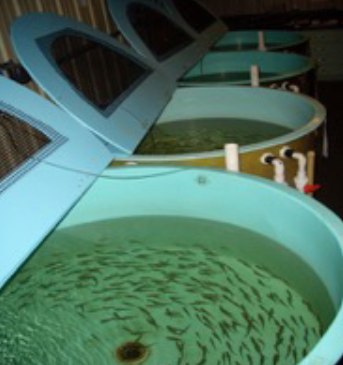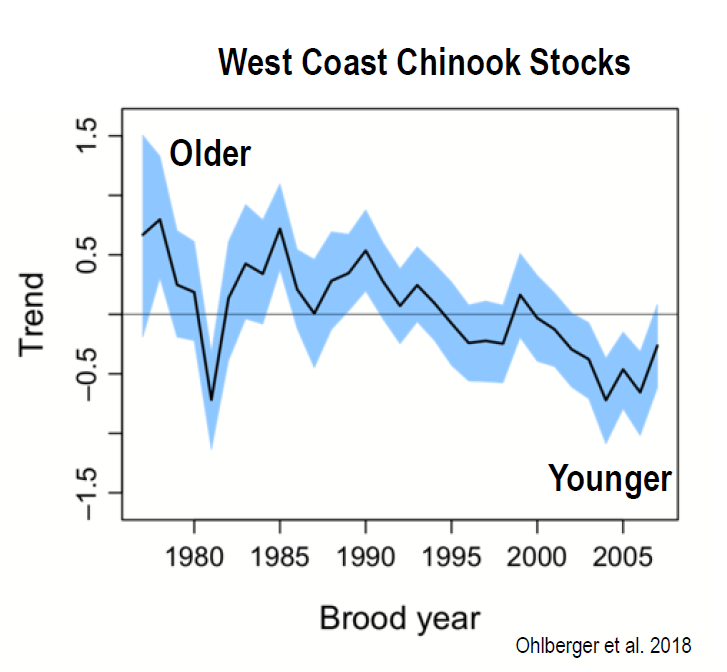Smaller Adults, Lots of Minijacks: NOAA Research Aims to Inform Hatchery Managers
- January 05, 2021
- John Harrison

There are three interesting takeaways from recent research by NOAA Fisheries scientists, who discussed their findings with the Council at its December meeting: 1) Chinook salmon are maturing younger and smaller than in the past; 2) the high number of Chinook minijacks – young fish that mature early – is concerning; and 3) changing the release timing of hatchery-bred steelhead could improve their survival. These results are intended to inform hatchery practices and also will be useful in 2021 when the Council reviews salmon and steelhead habitat and production projects that are funded through its Columbia River Basin Fish and Wildlife Program.
“Pacific salmon from Alaska to California are declining in abundance and maturing younger,” NOAA researcher Don Larsen said. “The basic take-home message is that fish are getting younger as they return to spawn, and this is kind of a big deal because smaller, younger fish negatively impact a number of factors in the population.”
He said the impacts include declines in the overall number of fish, the depth of the redds (egg nests) that fish can dig, the survival of their offspring, less diversity in age classes, and the fact that smaller fish deposit a smaller volume of marine nutrients than larger fish when they die after spawning. In addition, smaller adult fish have a negative impact on Tribal cultural, commercial and sport fisheries, he said.
Possible causes of the smaller size are impacts of climate change as the ocean warms, predation, and hatchery practices – about two-thirds of the Chinook salmon and steelhead that return from the ocean to spawn are hatchery-bred, he said. Also, hatchery fish in the ocean present competition issues with wild fish, and domestication of the populations when hatchery fish spawn with wild fish probably also is an issue, he said.
At the same time researchers are seeing smaller adult salmon and fewer of them, they also are seeing an increase in the number of minijacks. A minijack is a two-year-old sexually mature male salmon, only about 6-12 inches long (one year younger than a jack male). This is an issue because an abundance of minijacks is an indicator of an overall shift in the age of maturation – fewer fish are surviving to age 4 or 5, the usual spawning age. As well, minijacks have low relative reproductive success, compete with wild fish for food and habitat in rearing streams; and they can affect the accuracy of smolt-to-adult return calculations, an important gauge of salmon productivity.

“Minijacks are a canary in the coal mine,” Larsen said. High numbers of minijacks indicate a disruption of the adult age structure and loss of adult production, he said. Hatchery surveys in recent years “show minijacks are everywhere,” he said. Between 8 percent and 71 percent of the male fish released from hatcheries are actually not immature smolts, but minijacks. Wild fish populations produce far fewer minijacks.
The research suggests that hatchery practices could be changed to affect the age of maturation and therefore reduce the number of minijacks. For example, using natural seasonal water temperatures during rearing can produce more smolts, lower minijack rates, and lead to higher adult returns. Using feed with a lower fat content also can decrease the number of minijacks and increase the age of maturation, research shows.
In fact, the more closely the hatchery environment mirrors the wild environment, the less impact there is on factors including seasonal growth rate and fish size. “Mismatches in these factors may result in life-history differences including altered smolt development and migration timing, early age/small size at maturation, and reduced adult returns,” according to Larsen’s presentation.
Other research is showing steelhead raised in hatcheries have reduced fitness and poorer survival than wild steelhead. NOAA researcher Christopher Tatara said hatchery experiments showed that the age at which hatchery-bred steelhead smolts are released had lifecycle impacts including survival, migration behavior, and reproductive performance. Research shows that the growth rate of steelhead is established early in life after hatching, and variations in the temperature of rearing water and the length of time a fish spends in a hatchery before release will determine growth rate, and consequently smoltification. This information could be used to create rearing strategies that improve the rate of smoltification for steelhead.
Research showed that age-2 steelhead smolts had equal or better survival and migrated to the ocean faster than age-1 smolts, Tatara said.
NOAA also is studying how salmon and steelhead populations change genetically over time, how well hatchery-origin fish reproduce in the wild, and whether management actions are providing the desired results, NOAA researcher Ewann Berntson said.
All of these projects will inform decisions about improving existing hatchery programs and how to modernize hatchery operations, as many hatchery facilities in the Columbia River Basin are becoming obsolete. Fish culture practices are changing to conserve space, reuse water, control the hatchery environment, and reduce pollution.



